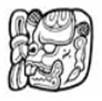| CMGG entry for syllabogram ha
|
|
Variant: knot-skull
MC JM K&H TOK.p22.r4.c1 Wikipedia
Notes · Wikipedia: https://en.m.wikipedia.org/wiki/File:Maya_Syllabary_Ha_1.jpg · In MotT2019 the theme was acrophony, and there it was explained that ha is derived from HA’, which means “fly” (the insect). · Do not confuse this variant of ha with one of the (only superficially) vaguely similar variants of CH’EEN (the “bundle and bird-head variant): o ha has a knot on the left (occasionally on top) and a skull on the right (occasionally on the bottom). o CH’EEN has a “bundle” on the left (occasionally on top) and a bird-head on the right (occasionally on the bottom).
Sub-variants (1) · A. Knot-skull o Left – knot: § Quite a distinctive feature is that the knot is asymmetric, i.e. the two ends are not similar, as they are in the reduced variant of ma or in the abstract variant of MUT (the EG of Tikal). § What makes it asymmetric is that it’s a “knot with tassels” – i.e. one end is a loop, and the other end is two “tassels”. § This is a known variant of hi. o Right – skull: § AK’AB at the top of the head, in a very high/wide forehead. § Medium-sized, round eye. § Nose hole. § Bone-jaw with two or three teeth. § %-sign at middle height, on the right. § Optionally, complex ear, optionally with paper strip pulled through hole in earlobe.
|
|
Variant: tooth
K&H TOK.p16.r4.c4 MHD.ZYC.1&2
Sub-variants (2) · Main sign: tooth outline with reinforced left wall and ceiling. · Top left: oval with: o A. Three tiny non-touching dots in a row, on the long axis of the oval (“bone property marker”). o B. Instead of the three tiny non-touching dots, a single curved line, multiple parallel curved lines, a single scroll, or nothing (this last could simply be erosion). The reference works tend to give only the sub-variant with three tiny non-touching dots, but a search in MHD on “blcodes contains ZYC” gives 33 hits, of which only four have the three tiny non-touching dots – all the others are a mix of the alternatives given in “B”.
· Do not confuse this variant of ha with the tooth variant of ye, which has a “dot cascade left” in the top left, instead of the oval shaped “bone property marker”.
|







